Movie Review By: SFAM
Year: 1990
Directed by: Marianne Trench
IMDB Reference
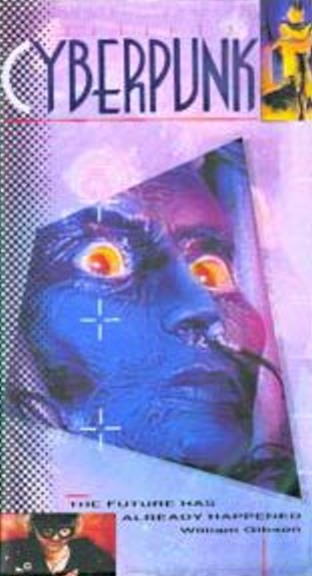
Overview: Cyberpunk is a documentary that looks back at the 80s cyberpunk movement, and more specifically, how this has led to a trend in the “real” world where people were starting to refer to themselves as “cyberpunk.” The documentary sees “cyberpunks” as being synonymous with hackers. A number of writers, artists, musicians and scientists are interviewed to provide context to this movement. The guiding meme, as told by Gibson, is that information “wants” to be free. 60s counter-culture drug philosopher, Timothy Leary, provides a prediction that cyberpunks will “decentralize knowledge,” which will serve to remove power from those “in power” and bring it back to the masses. Many different potential technologies are discussed, including “smart drugs,” sentient machines, advanced prosthetics – all of which serve to give context to the idea of post-humanity and its imminent arrival on the world stage.

As a documentary, Cyberpunk is haphazard. Some of the interviews, such as those by William Gibson and Timothy Leary are interesting, while others are mired in mediocrity. To mitigate the boredom of some of these, the film makers stoop to using cheesy visual effects to increase the interest. In one case, an interviewer is duplicated to four small windows, and in another, the talking head is completely moiréd out except for their eye. In fact, we are barraged by a stream of weird, experimental effects – one imagines that these are supposed to give us the “hacker-cyberpunk mindset” or something. In general, they don’t work, but I’m guessing the late 80s CG graphics probably looked far more futuristic back then.

The Bottom Line: This documentary really almost serves as a time capsule for capturing a still emerging hacker counter-culture. From a cinematic perspective, I’m saddened that Blade Runner was virtually non-existent in this. While they covered books, music (Front Line Assembly was the main one), science and art (Jaron Lanier, who coined the term “Virtual Reality”), their coverage of film was pretty sparse, generally restricted to obscure animes (which looked cyberpunk, but unfortunately I’m not familiar with). I will say I liked the younger William Gibson LOTS more than on his No Maps for These Territories documentary. He talks excitedly about cyberpunk, hackers, and our direction towards post-humananity. Ten years later, Gibson comes off completely bored with these ideas, and almost seems to wish he was never associated with the term, Cyberpunk.
~See movies similar to this one~
Movie Review By: SFAM
Year: 2002
Directed by: Gary Fleder
Written by: Philip K. Dick (story), Scott Rosenberg (Adaptation), Caroline Case et a. (screenplay)
IMDB Reference
Degree of Cyberpunk Visuals: Medium
Correlation to Cyberpunk Themes: Medium
Key Cast Members:
Spencer Olham: Gary Sinise
Hathaway: Vincent D’Onofrio
Maya Olham: Madeleine Stowe
Cale: Mekhi Phifer
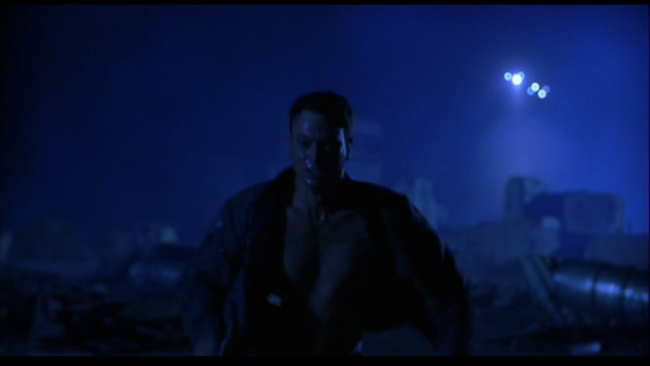
Overview: Impostor got bashed by critics for having bizarre cut always, too many slow motion scenes, and generally weird and herky-jerky cinematography decisions. Additionally, others criticize it due to originally being a 30-40 minute short that got extended into a full-length movie. While all true, I truly like both the story (basically the Fugitive, done in a near future setting) and the acting, especially by Gary Sinise and Madeleine Stowe. While the cinematography is definitely subpar in this Philip K. Dick story, the movie itself is still worth a watch.
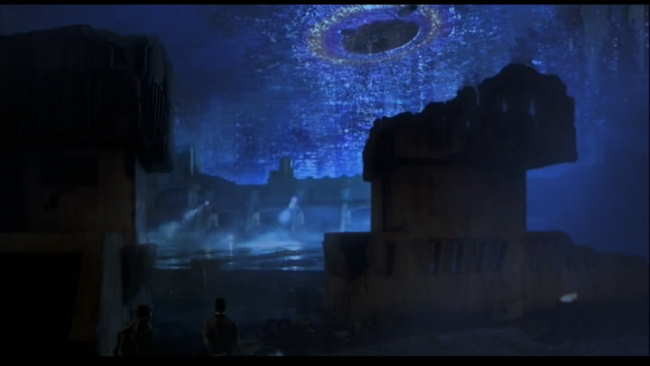
The Story: Impostor is set in the year 2079, a time when a race of aliens are attempting to invade the earth. To protect the population, humans now live in high-tech “bubbles” which seem to be able to keep out Alien weapon systems. Because of this, the aliens have resorted to creating DNA-based replicants, not unlike those in Battlestar Gallactica, by a process which apparently involves copying captured humans. These replicants are in actuality very powerful bombs, but have no self-awareness of being replicants – when their “trigger” is invoked (such as being in close proximity to their target), they explode.
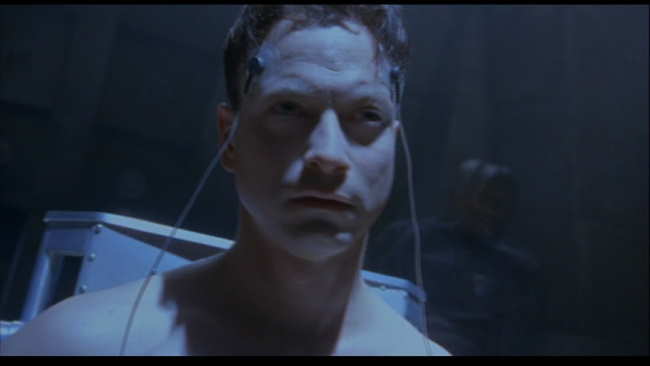
Sinise plays Spencer Olham, a weapons scientist who has been accused of being replaced by a replicant (called a cyborg in the movie). The security head (Vincent D’Onofrio) captures him and threatens to rip out his heart in order to prove that he’s not a human. Sinise escapes and then engages on a journey to prove his innocence. Olham determines that he can prove his innocence by equipment at the hospital where his wife (Madeleine Stowe) works, that compares a previous body scan with his current body. Unfortunately, he’s already gotten out of the city, and now needs to figure out how to get past security to return.
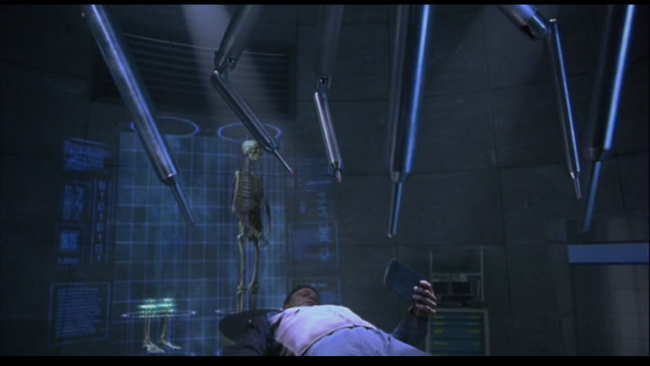
How Do You Know You’re You? This, in essence is the question Impostor is asking when it’s not in chase-filler mode. Is Spencer Olham a human caught in a horrid mistake, or is he a cyborg comprised of human-like bio-matter that is in actuality a powerful bomb sent by aliens to infiltrate Earth’s defenses in order to kill human leadership? If you were a cyborg-replicant imbued with the memories of the original host, how could you figure it out? Imposter briefly mentions the notion that the cyborgs don’t have a soul, but this is never pursued. One wishes they had come up with some way of quantifying a soul. But in the end, we are left to answer this question ourselves.
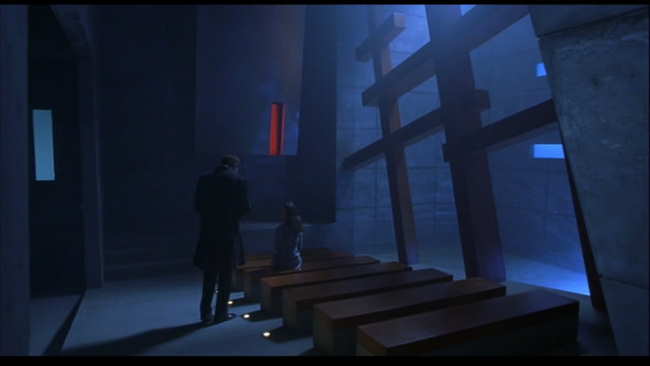
The Middle “Chase” scenes are Filler: Originally, Impostor was shot as a 30-40 minute movie short that was intended to be part of a larger collection. Apparently, Miramax liked the short enough (or cooled to the short collection idea) that they wanted it extended into a full length feature film. However, in doing so, they were left with a relatively tight beginning and tight end, and then a vast chasm of nothingness in the middle. By and large, the middle is filled with semi-pointless chase scenes that are sprinkled with people that aren’t germane to the central plot. Now we get a whole underground dystopia thing added to the mix, whereby it turns out that the nice hospital is ONLY for those who live in the bubble, while those in the outer area get little or no medicine and support. In its better moments, the middle part of the movie seems to want to emulate a “Fugitive” type feeling, but this doesn’t always work well. The DVD also includes the original movie short which is definitely worth a watch.
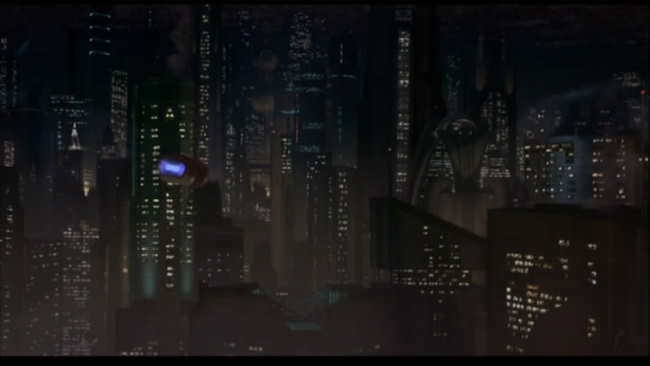
The Visuals: Impostor’s vision of the future is terrific in some places and haphazard in others. The cityscape scenes look right out of blade runner, the bubble city coverings, torture look great, but the majority of Imposter involves treks through regular looking tunnels. The torture equipment and medial imagine equipment are both more than passable. Imposter is strongly dominated by blue tones, which pervade most every aspect, from the chase scenes to the interrogation scenes.
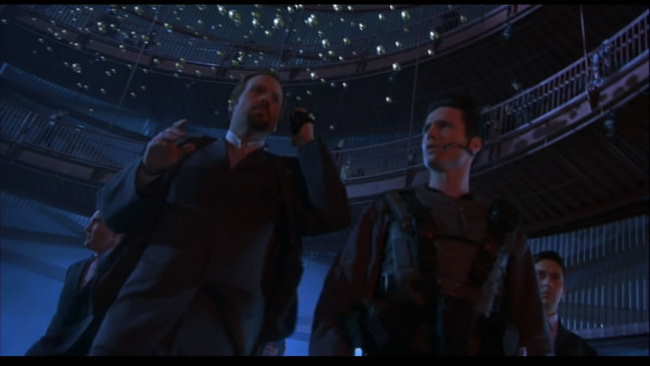
The Acting: By far, the best aspect of Impostor is the acting.Gary Sinise in particular really sells his role well, but Madeleine Stowe and Vincent D’Onofrio also give high quality performances, and Mekhi Phifer is at least passable. With slightly worse performances, Imposter could have easily ended up in the cheesy “B” Movie bin. The effects are uneven enough (some looked great, others looked TV-ish) that solid acting was a must to keep this movie watchable.
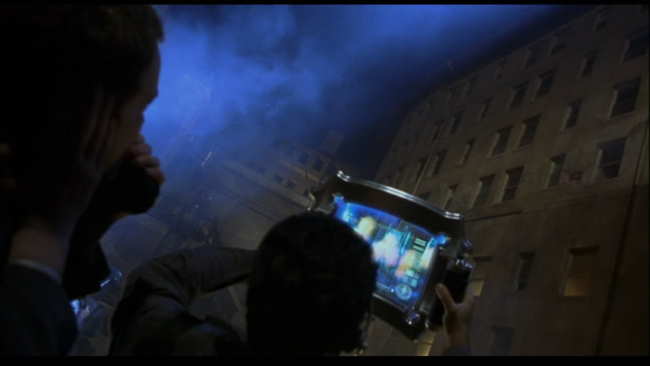
The Editing: Impostor is rightly criticized for crazy and continuous cut-shots. Rare is the shot that lasts more than 4 to 5 seconds before cutting to another view. The goal was to add to the tension of the chase scene, but the editors went overboard. Especially when combined with some strange shot angles, Imposter almost takes on an experimental vibe, as if they weren’t sure what would work, so they tried various different things.
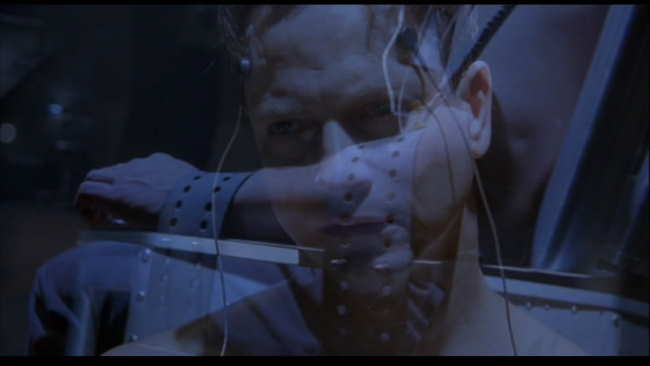
The Bottom Line: While this “Fugitive-like” movie has lots of interesting scenes, it’s the ending that I really like - definitely a cool twist. The acting is solid and the visuals are sometimes, but not always, pretty decent. There are lots of pointless tunnel-running that easily could have been cut by 15-20 minutes, and also, there are enough questions and plot holes that stop Imposter from being a great movie. Still, the question of determining humanity is an interesting one, and is well executed.
~See movies similar to this one~
Movie Review By: SFAM
Year: 2004
Directed by: Shinji Aramaki
Written by: Masamune Shirow (Manga), Haruka Handa & Tsutomu Kamishiro (screenplay)
IMDB Reference
Degree of Cyberpunk Visuals: Very High
Correlation to Cyberpunk Themes: Medium
Key Cast Members:
Deunan Knute: Ai Kobayashi
Briareos: Jûrôta Kosugi
Hitomi: Yuki Matsuoka

Overview: Masamune Shirow’s Appleseed recently got a second anime treatment. The last was in 1988 – this time, in 2004, the anime is done up in eye-popping 3D graphics. With a budget of only 10 million as compared to over 90 million for a movie like The Incredibles, we shouldn’t be expecting too much. Surprisingly, we get far more than expected, especially with regards to the wonderfuly rendered backgrounds. While the animation is interesting enough, the story is more problematic. So too are the change in the feel of the characters. This is really where the original version succeeds far better than Aramaki’s version.

The Story: Appleseed takes place in the year 2131, a war-ravaged dystopian future where most all of human society is in ruins. Over two years after the last war, the only example of advanced human civilization is a newly made city called Olympia, which has been engineered to be a created as a perfect refuge from the rest of the world. Over half of the city’s inhabitants are comprised of bio-engineered “biodroids,” which are human-like beings designed to serve specific roles in the society. An all-knowing computer named GIA supports the city council in controlling all aspects of city life.
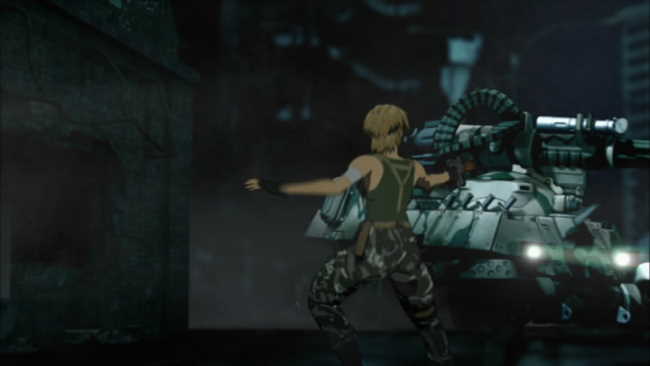
Deunan Knute, a fighter extraordinaire has been living alone in the wastelands, not realizing that the war is over. She is beset by two warring groups of fighters, one of which who is trying to kill her, and the other group, which rescues her and takes her to Olympia. There she is re-acquainted with her long lost lover, Briareos, who now has been transformed into a cyborg after his body was lost in the war. She is tasked to join “ESWAT,” a special mecha-enabled police force that keeps order within the city. Deunan also befriends a biodroid named Hitomi, who shows her around the city. Unfortunately, Deunan barely gets a chance to settle down before the assassination attempts on her life start.
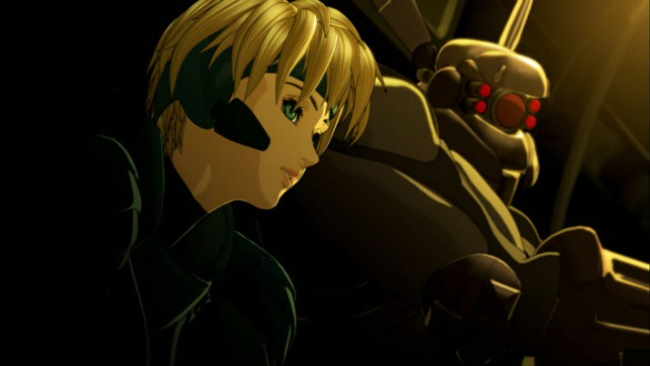
Duenan quickly learns that she has been dropped in the middle of a power struggle between humans, who are concerned that the biodroids secretly aim to exterminate them, and biodroids, who worry the same about the humans. Somehow, Deunan has become essential in this struggle, yet it has nothing to do with her fighting capabilities. It turns out that her parents, before dying, developed a method for biodroids to reproduce, which would make them almost exactly like humans. But this research was lost long ago. Now, Deunan has become a pawn for both sides of this struggle, and worse, it appears as if her ex-lover, Briareos has chosen sides.
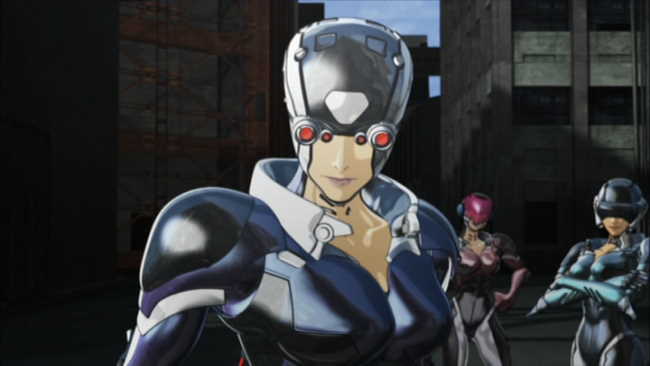
Unfortunately, the story in this version of Appleseed is problematic at best. There are too many sub-plots that obfuscate the key points. The myriad of loose ends introduced that are never followed up on. Gia, the sentient computer that runs Olympus is the probably the worst casualty. We get introduced to her, and, if you know something of the Appleseed story from the Manga, you expect to see lots more than what actually ends up being conveyed. In the end, the plot centers on a simple theme of racism. This is a shame as there were so many interesting cyberpunk aspects of Olympus that get short-circuited.
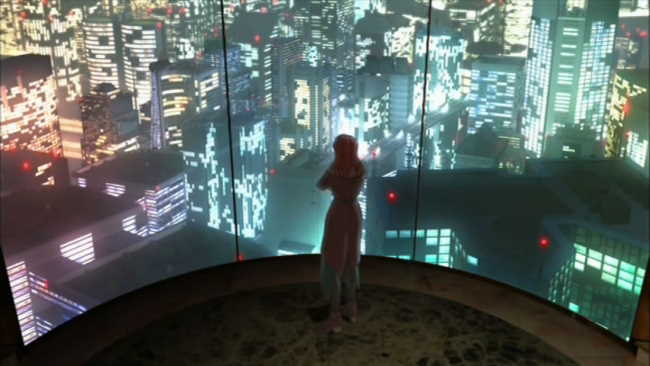
The Animation: Appleseed’s backgrounds are wonderfully rendered. This more than anything accounts for the majority of the “wows” Appleseed received. They are done in a way that allows 3D camera maneuvering, so as to allow you to see the same scene from multiple angles, and at times, even provides Matrix bullet-time effects. For the most part, the 3D CG overlaid with 2D cell shading really works. It’s an extension of the idea we saw in Malice@Doll, only with far better rendering tools. The machines look especially awesome. Both the Gunhed style tanks at the beginning of the movie and the platform sentinels at the end. Unlike many cyberpunk movies, there isn’t a dominating color palette in Appleseed, but the color scheme seems to stick more often than not to light and dark shades blue-greens, with yellow & browns in transition scenes.
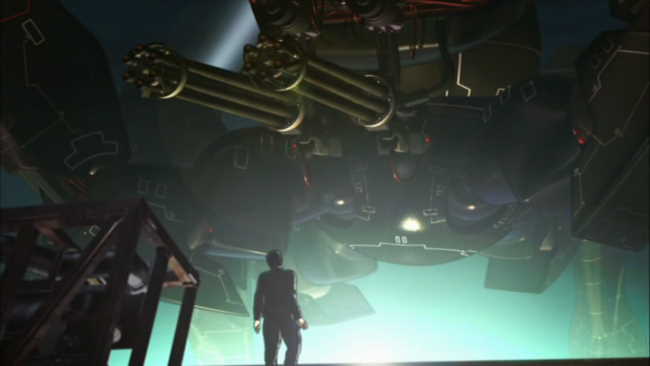
In terms of the characters, only Deunan Knute really looks polished. Her body movements, facial expressions and general actions really work. The rest, especially the human characters, often look stilted in their moments. Hitomi, their biodroid friend, is especially problematic at times. This might be due more to the motion-capture techniques they use, which work wonderfully for the city, but not so well for the characters. Also, I really dislike the way they animated the hair. The hair on the humans in the 2004 edition look like something out of Reboot. However, considering the budget, I think they made the right decision in spending scarce resources on Deunan. Had they just made everyone look slightly better, Appleseed would have faltered horribly. By at least making Deunan polished, they developed a star that fit right alongside their wonderful backgrounds.
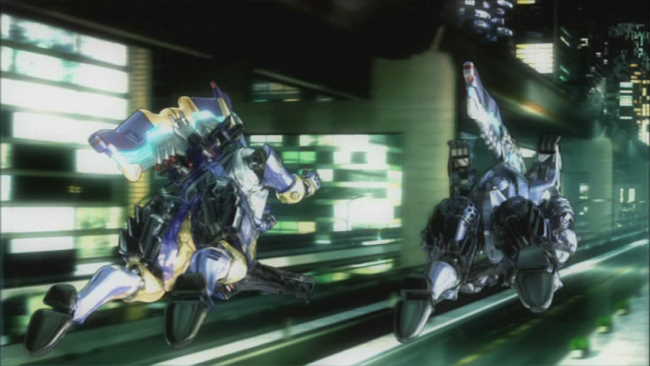
The Sound: Many times throughout the anime, Appleseed plays more like a music video than it does a movie. The modern heavy rock beats worked well for the action scenes. And truly, the action scenes are where Appleseed excels. There, the 3D positional sound, the music accompaniment and the 3D CG graphics are at their absolute best. The accompanying score really wasn’t all the memorable, but at least served up the slower paced moods fairly well.
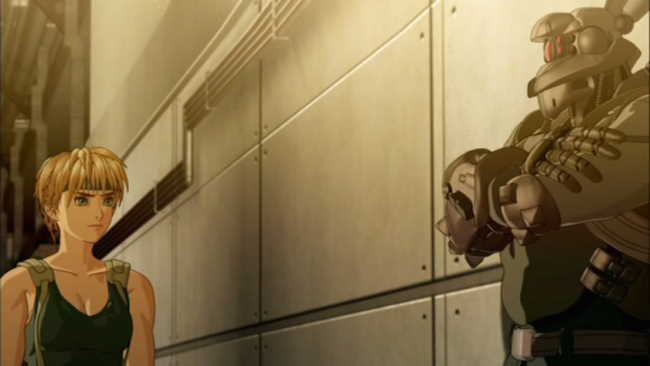
Differences From Shirow’s Work: While both animes deviate from Masamune Shirow’s Appleseed Manga, Aramaki’s version is the most egregious. While the 2004 version starts outside of Olympia as the Manga does, it only has Duenan there, whereas in the Manga has both. This version introduces a new dramatic twist of Duenan and Briareos getting back together for the first time in two years. While this in itself isn’t bad, the side-effect is: these two characters are no NOTHING like the Manga. The Duenan Knute and Briareos of Shirow’s Manga, and of the 1988 version, are precursors to the Ghost in the Shell’s Motoko and Batou. Here, Briareos is a moody, lost soul trying to deal with his cyborg body, and Duenan is far more vulnerable than tough. The playful chemistry we see between these two both in the Manga and the 1988 anime is completely missing here. For those who aren’t familiar with the Manga, this probably won’t bug you, but it certainly sapped some of the enjoyment out of this movie for me – so much so that I’m dropping a star off the review for it.

The Bottom Line: Appleseed is definitely worth seeing for the visuals alone. While some of the characters don’t work, the Duenan, the machines and the action scenes work wonderfully. Unfortunately, the story doesn’t equal up. Too many elements are introduced and then discarded in favor of a truly simplistic storyline. They could have done better. Also, as I mention above, this is not the Deunan and Briareos I’ve become familiar with – these characters are different from both the Manga and the earlier anime. This bugged me enough to drop a star from the review, but you might not mind so much.
Page 2: More Screencaps –>>
~See movies similar to this one~
Movie Review By: SFAM
Year: 1999
Directed by: Chris Columbus
Written by: Isaac Asimov & Robert Silverberg (short story/Novel), Nicholas Kazan (Screenplay)
IMDB Reference
Degree of Cyberpunk Visuals: Low
Correlation to Cyberpunk Themes: Medium
Key Cast Members:
Andrew Martin: Robin Williams
Little Miss Amanda Martin/Portia Charney: Embeth Davidtz
‘Sir’ Richard Martin: Sam Neill
Rupert Burns: Oliver Platt
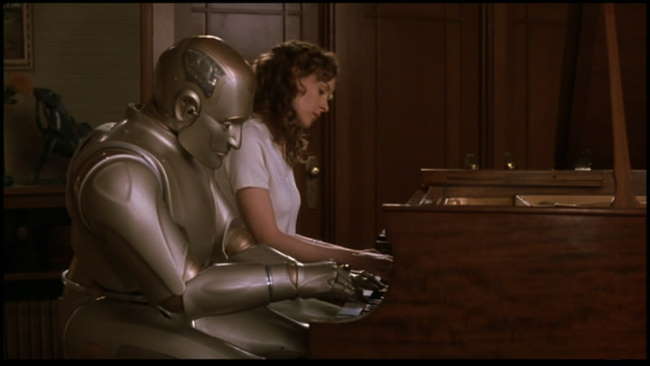
Overview: What a strange movie to try to categorize. Bicentennial Man seems like a Sci-Fi movie at times and a drama at others. In many ways, Bicentennial Man is hit or miss. Robin Williams and Embeth Davidtz are terrific, but the script itself really has trouble figuring out what movie this is going to be. Still, but there’s enough here to make it worth a viewing, as long as you don’t mind overly sappy movies.
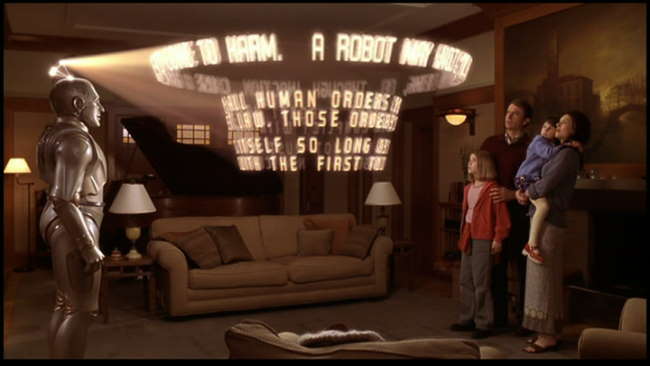
The Story: In the very recent past (2005 – but it was the near future in 1999), the Martin family has gotten a new appliance – a robot named Andrew. And while Andrew obeys the three laws of Robotics, and Andrew (Robin Williams) comes right out of the box with a sense of unexpected wonder. Andrew seems interested in all sorts of things that Robots aren’t normally interested in. In spending time with the youngest daughter, Little Miss (Embeth Davidtz), Andrew learns the meaning of love and humanity. Richard Martin, the father (Sam Neill) is intrigued by this and brings Andrew back to the corporation to talk about his “uniqueness.” The robotics maker is worried that this “bug” will ruin business and wants him terminated immediately. Luckily for Andrew, Richard likes his uniqueness, and decides to spend his time teaching Andrew everything a sentient person needs to know.
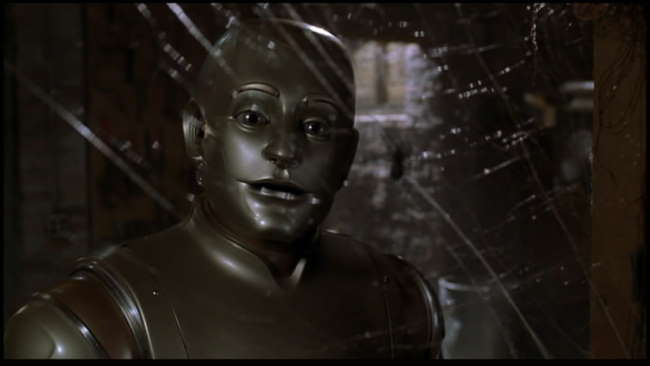
Andrew continues to grow and expand his capabilities and thinking. He becomes a master clock maker, and after working out the specifics of getting a bank account, makes millions in selling them. Time hurries on (well, not really – this part could have been edited somewhat) and Andrew’s family grows old and starts to die off. Andrew eventually asks and is granted his freedom, but still hangs around the family, especially Little Miss. He eventually goes in search of others like him, and then later finds ways of “upgrading” his appearance to become human-looking. It is at this point that he meets Little Miss’s grand daughter, Portia. He is captivated by her immediately, and begins to contemplate sharing the love with a human. But in order to do so, he decides he must be “declared” a human – this too will require change.
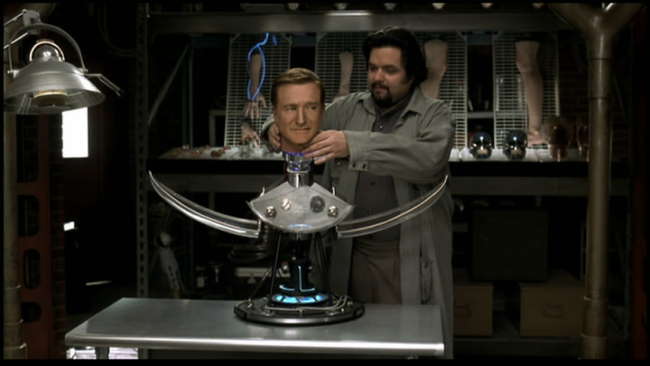
Is it cyberpunk? I was really torn about whether or not to include Bicentennial Man on this site. It clearly is not a cyberpunk movie in tone, in that the near future is closer to an idyllic situation than a dystopic one. We also don’t see a massive corporation controlling society. In fact, the story isn’t focused on society at all – it’s on an individual. So why include it in a cyberpunk site? Because of the post-human nature of the story Bicentennial Man presents us. Here we see an example of an android as a post-human versus a human transformed into a cyborg. The whole question of sentient androids and their quest for freedom and self-determination is raised and explored, although not to the extent I would have liked. In this Idyllic future, Androids are essentially still considered high-tech kitchen appliances. In its better moments, Bicentennial Man poses the question our society may face one day – when do we grant human rights to the products of our innovation? But again, I do fully appreciate that this move sits more in the gray area than it does as a cyberpunk flick.
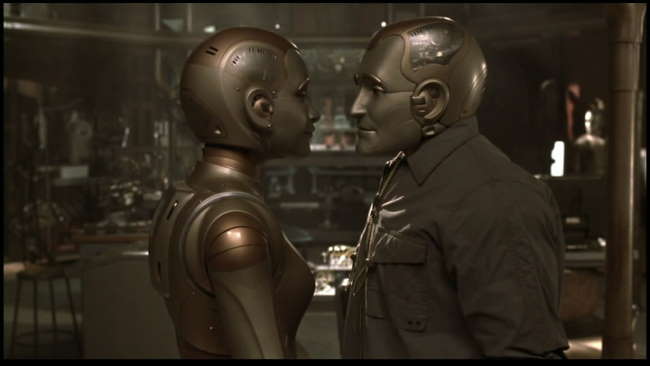
What defines humanity? One really wishes Bicentennial Man spent more time elaborating these questions instead of getting mired in a love story. While the love story was interesting and well done in an overly sappy sort of way, it is far less interesting than the question of what would make androids human. Here we have two androids – one clearly nothing more than a kitchen appliance, and the other something significantly more. Andrew has freewill, self-determination, is self-motivated, and clearly seems to “feel” love. Over time, he upgrades his body with the help of robotics tinkerer, Rupert Burns (Oliver Platt) so that he is human in virtually every way (can feel, have sex, etc.). In Bicentennial Man, Andrew pursues being declared “human” versus having human rights. Unfortunately, the movie glosses over how Andrew had the rights to maintain a bank account, own a house on the beach, or even a company. It’s clear that humanity encapsulates quite a few requirements – this movie focuses on our lack of immortality as a defining characteristic of humanity. While this may be true, it’s hardly complete. We are left with the idea that Andrew has all the other (unstated) traits but this one.
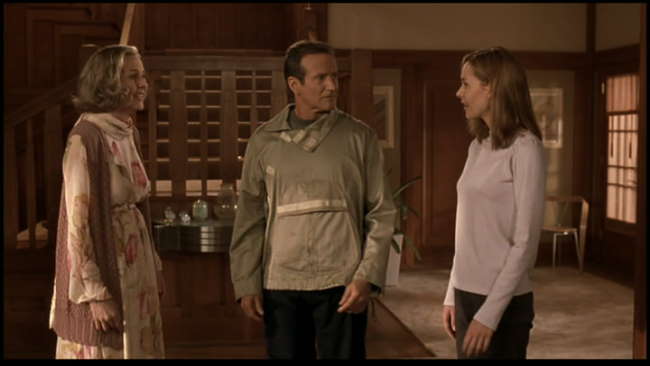
The Love Story: Bicentennial Man is a love story, and although it’s sappy, it’s still a complicated one. Andrew was really in love with Little Miss, but neither he nor her (who was also in love with him) were strong enough to admit it. Yet Andrew has another chance when her grand daughter, Portia, is an almost perfect image of Little Miss. Even then Andrew has trouble coming to terms with the possibilities. In the end, Andrew’s potential relationship with Portia represents his last step transforming to human.

The FX: While Andrew’s expressions are well done, clearly lots more could have been undertaken here. Every so often, we get glimpses of futuristic cityscapes, but unfortunately, these appear more tacked on than integrated. Throughout most of the story, which takes place over the course of 200 years, we see no interesting change in society. Literally, the technology doesn’t seem to affect life at all. This really is an almost unforgivable lack of thought and imagination. While there was scene after scene of little love and caring vignettes, futuristic visions were pretty much non-existent here – they could have easily been integrated.
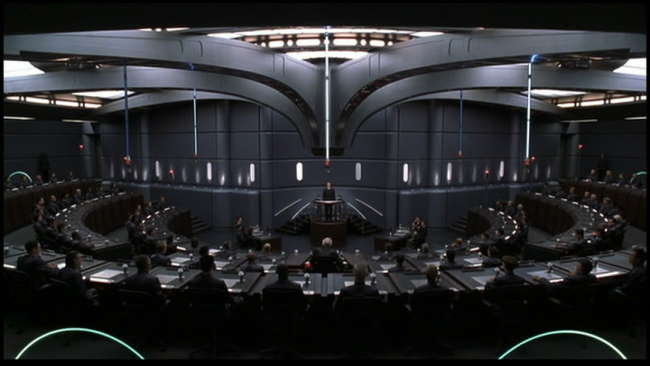
The Bottom Line: There is a number of problems with Bicentennial Man which detracts enjoyment. For starters, Andrew’s uniqueness is essentially magical, as no explanation is ever given. I would have hoped as Andrew became an inventor supreme of human and android cyborg parts, he would have spent time questioning his own existence and attempted to replicate it. Also, the length of time spent on Andrew with his family could probably have been edited down somewhat, and the time spent on the more interesting android questions and their effect on society could have been expanded. Still, there is enough here to make Bicentennial Man worth a watch. Williams and Davidtz have great chemistry and make the sappy love story work. And the questions posed are explored in at least enough detail to make you think.
~See movies similar to this one~
Movie Review By: SFAM
Year: 1991
Directed by: Shozin Fukui
Written by: Shozin Fukui
IMDB Reference
Degree of Cyberpunk Visuals: High
Correlation to Cyberpunk Themes: Medium
Key Cast Members:
Pinocchio 964: Hage Suzuki
Himiko: Onn Chan
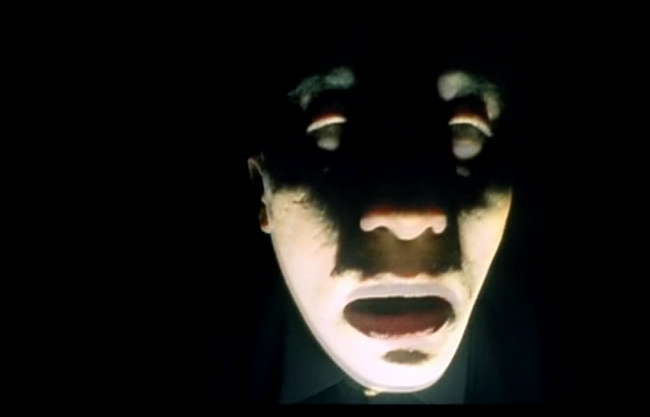
Overview: Back in 1991, Shozin Fukui and crew created a no-budget movie that provided yet another view of Japanese Cyberpunk, one very different from the first Japanese Cyberpunk movie, Tetsuo. In 964 Pinocchio, we don’t get an external merging of man and machine parts – instead, we see the residue of extreme internal struggles – ones that overwhelm the protagonists. The images are very intense, and the pacing is erratic and fast paced. While this movie is uneven and haphazard in places, 964 Pinocchio is definitely a unique experience.

The Story: In this film, 964 Pinocchio (Hage Suzuki) is a strange type of cyborg – someone that used to be human but now has been transformed into a sex slave sold as product. Unfortunately, he no longer “functions” so his owners, a pair of sex-crazed, truly bizarre and sadistic chicks, have thrown him out in the street. Simultaneously, a nurse with a mysterious past, named Himiko (played by Onn Chan), has lost her memory, and she too has been evicted to the streets.

The two outcasts meet up and seem to have a strange attraction to one another. As 964 Pinocchio is essentially a child who seems to have little understanding or awareness of the external world, Himiko takes care of him. She takes him to her living quarters in the basement of a deserted building, and takes him on a food shopping spree where they steal and eat food in the grocery store. Himiko finds out that the corporation that produced Pinocchio is feverishly looking for him, as they are afraid that their illegal process for creating sex slaves will be made public.
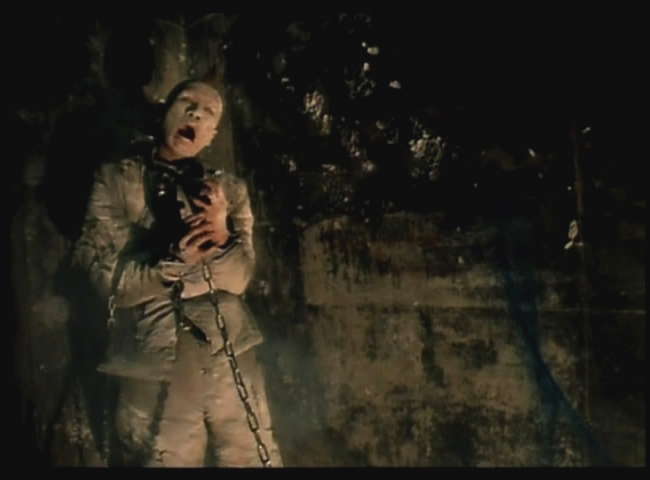
Eventually, 964 Pinocchio starts to gain awareness, and begins to wonder what has happened to him. After becoming frightened and agitated, Himiko calms him down, and then they both realize they have found a “like” soul and then make love (apparently 964 Pinocchio is able to perform when his feelings are re-engaged). Unfortunately, this event unleashes unseen forces inside of 964 Pinocchio – forces that are past the point of control. In short, all hell breaks lose – 964 Pinocchio begins spouting bodily fluids of all kinds and Himiko is thrown against the wall, and finally begins experiencing her own version of the horror. From there, the movie becomes a experiential voyage into the crazed and surreal. The corporation is still after 964 Pinocchio, but they soon discover he is not the same as he once was.
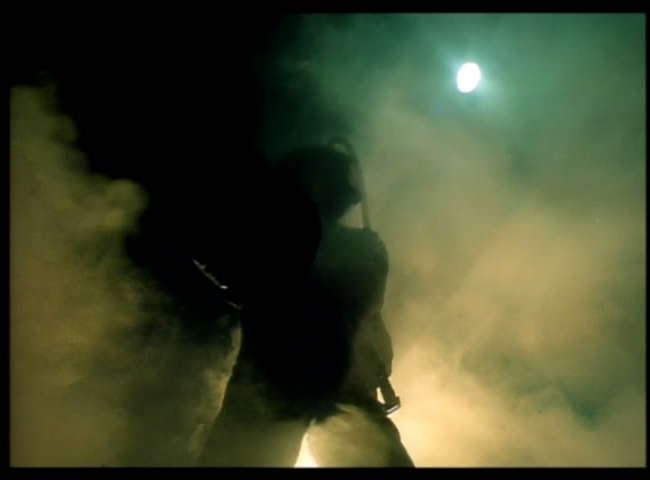
Rubber’s Lover is the Prequel to 964 Pinocchio: Even though it was created 5 years later, Fukia’s Rubber’s Lover is a sequel of sorts to 964 Pinocchio. In this film, we never really understand the process for how Pinocchio was created. Rubber’s Lover gives us a view of this. While the cover for the DVD describes 964 Pinocchio as an android, he’s really not. In fact, he’s virtually all human (although there is a drill to the forehead scene that shows brain matter being removed). If Rubber’s Lover is any guide, he was created by intense sound waves and special chemicals. So at one point he “was” human, but now is “post-human.”
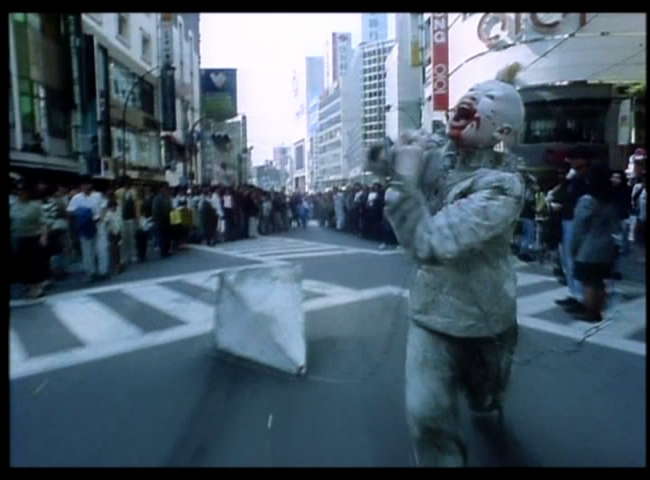
Note to Low Budget Japanese Cyberpunk Film Makers – Use B&W: Because of the low to no budget nature of 964 Pinocchio, the FX are not top quality. While they probably worked better prior to the CG world that we have today, similar to Videodrome, they look very dated in places now. This takes away from the impact of the movie to the point that it just doesn’t really work now unless you put it on a big screen and really crank up the sound. In comparing Tsukamoto’s Tetsuo (a B&W movie) to Tetsuo II: Bodyhammer (a color movie) and Fukui’s Rubber’s Lover (a B&W movie) to 964 Pinocchio, it’s clear that the mood, visuals and ambiance required for Japanese Cyberpunk is FAR better provided by B&W over color. In addition to both Tetsuo and Rubber’s Lover being better movies, they are both FAR more immersive. The low-budget B&W effects don’t detract from the mood, whereas in comparison the color effects look very fake. As an added benefit, shooting in B&W gives the film maker the a critical tool for cyberpunk mood setting: shadows. The use of shadows in a B&W film serve to create a dark, noir feeling which automatically serves up a non-normal mood.
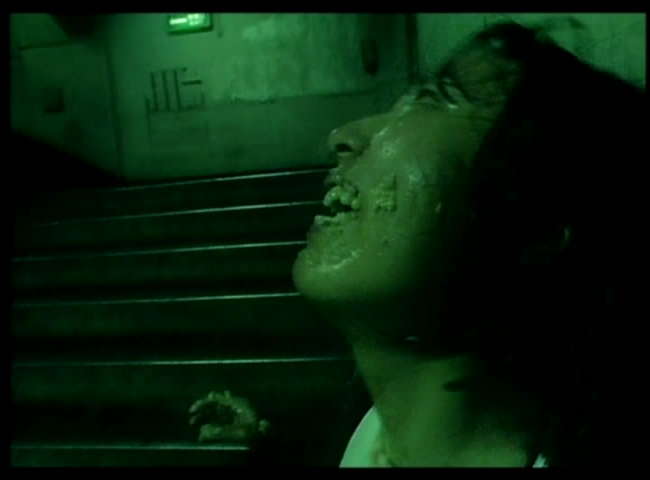
If You Have Vomit Fetish, 964 Pinocchio is For You! Fukui CLEARLY has a vomit fetish, and decides to share it with us in 964 Pinocchio. We’re not talking a wee bit’O vomit coming out - we’re talkin GALLONS worth! Himiko in particular vomits, wipes it on herself, wallows in it, and then eats it all back up! Yummy!
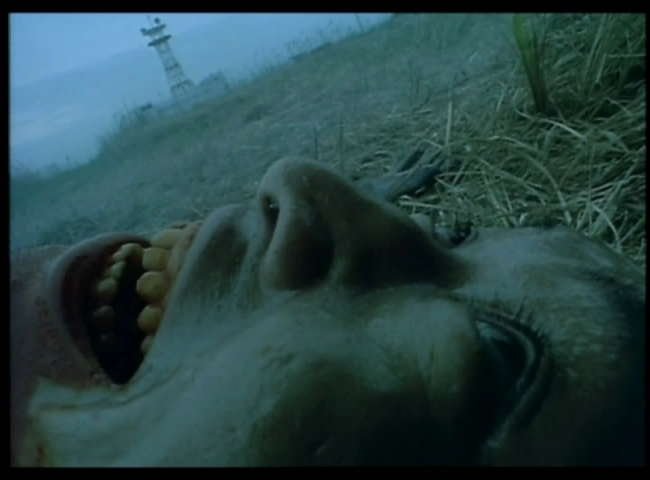
The Bottom Line: 964 Pinocchio is not polished fare, but it does etch out a place in the history of cyberpunk. The story is rather basic, and is really beside the point (many are left confused at the ending – page 2 gives a spoiler understanding if interested). The purpose is to create an immersive mood that details what happens when a dominant power emerges and exceeds human physical capacities. 964 Pinocchio is not for everyone – in fact it’s for a select few. If you aren’t a fan of extreme horror, gruesome imagery, constant screaming, jagged camera work and intense emotions, this movie is probably not for you. If you just want to see a Fukui film, you’re probably better off picking Rubber’s Lover. But if you want an instance of Japanese Cyberpunk in color – the first one in fact – 964 Pinocchio merits a watch.
Page 2: More Intense Screencaps and Spoiler Understanding of the Ending–>
~See movies similar to this one~
Year: 2004
Directed by: Omar Naim
Written by: Omar Naim
IMDB Reference
Degree of Cyberpunk Visuals: Low
Correlation to Cyberpunk Themes: Medium
Key Cast Members:
Alan W. Hakman: Robin Williams
Delila: Mira Sorvino
Fletcher: James Caviezel
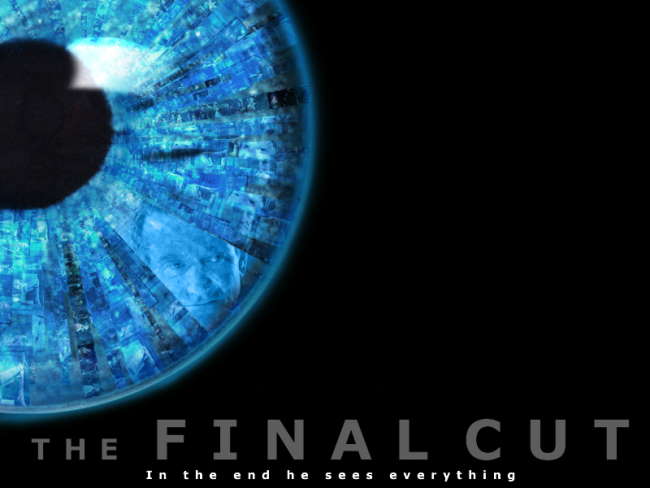
Overview: Overview: Sometimes we find a movie that has an idea so intriguing that it just can’t fail to be great – yet the director still finds a way to screw it up. The Final Cut is this kind of movie. The Final Cut explores the idea, “If every moment of your life was recorded on camera, would you live differently?” While you might expect a focus on the changes to society this technology engenders, instead, it turns out that the entire purpose of a camera implanted in you at birth is to have a paltry video “rememory” of your life at your funeral!!!! Gee, wow – yeah, that’s what I’d do with that technology – screw up my whole life so that people at my funeral can be bored to death with even MORE home movies!
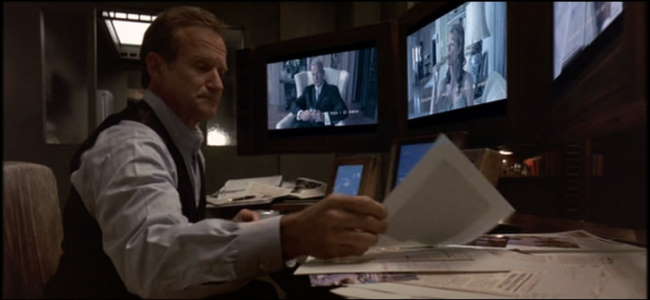
Cutter Code of Ethics
i. A Cutter cannot sell or give away Zoe footage
ii. A Cutter cannot have a Zoe implant.
iii. A Cutter cannot mix Zoe footage from different lives for a Rememory.
The Story: The Final Cut takes place in a near future scenario that looks almost exactly like the present, with one exception – a technology that can be implanted directly into the eyes prior to birth is now in vogue. The purpose of this technology, created by the Zoe corporation, is to record your life so that upon your death, a “Cutter” can compose a “rememory” of your life to immortalize you for all time. This “Rememory” isn’t really representative of someone’s actual life, but is instead a compilation of how the family members “want” to remember you (hence, the term “rememory”). Alan Hakman, played by Robin Williams, is a Cutter-extraordinaire. He is brought in by family members when the deceased was a major scumbag in real life. His job is simple – he must take the available memories and “compose” a final cut of their life that leads everyone to think this scumbag was actually a saint.
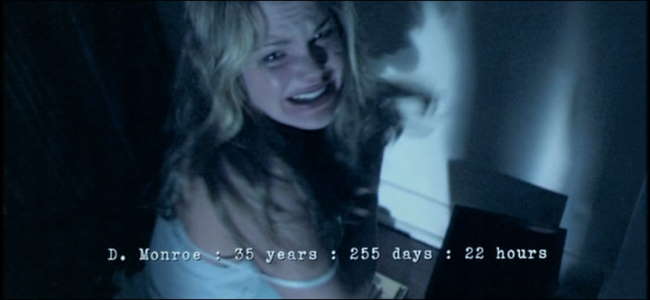
Unfortunately for Alan, his latest rememory scumbag – a child molester – is high profile enough that there are people looking to gain access to this guy’s memories. Alan is in danger of breaking one of the rules of the Cutter oath (a Cutter cannot sell or give away Zoe footage). Worse, in viewing the footage, Alan sees a childhood friend who he thought he accidentally killed dead long ago. Now horrible memories of Alan’s childhood come crashing back – so strong that he can’t help but investigate. And in the process of doing so, Alan realizes he may have broken another more critical Cutter law.
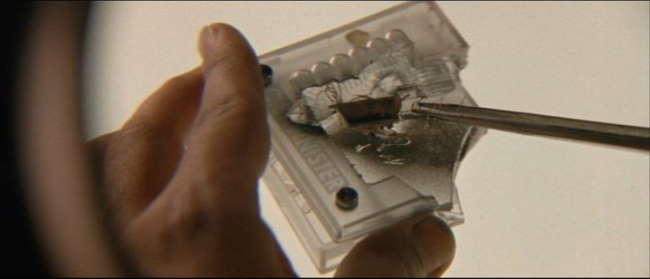
The Use of the Technology: The most annoying part of The Final Cut is the idea that a technology this powerful would only be used to compose a home movie at a funeral. This simply doesn’t pass common sense muster. Even if the Zoe Corporation wouldn’t allow scans of the technology when alive, a groundswell of techy-hacker types would find a way to do this. More likely, a technology such as this would be accessed by people on a regular basis. An audio-video record of everything you see could spurn all sorts changes in society. While the Final Cut touches on the change in personal interaction, this becomes hard to believe if the only implication is that someone’s entire life will be boiled into a 30 minute slice at the funeral. I mean, what are the chances that anything incriminating would show up there, especially if the job of a Cutter is to suppress all the juicy sleazebag stuff? Again, terrific idea with lots of promise – but the Final Cut almost completely wastes it.
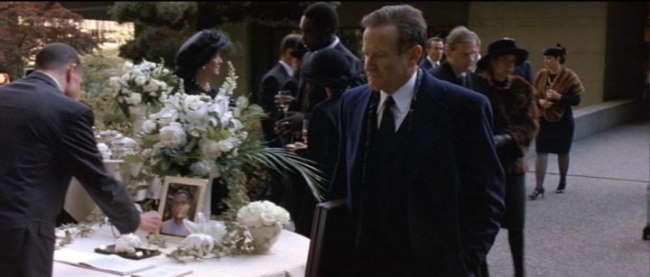
“My job is to help people remember what they want to remember.”
The Acting: Even though the script is hurting in this movie, Robin Williams turns in a terrific, if sedated performance. He really adds credibility to a plot that otherwise could have been horribly received. Unfortunately, Mira Sorvino in a supporting role really isn’t given enough to have the chance of making much of an impact. James Caviezel does turn in a cool performance as a conflicted bad guy.

The Bottom Line: Visually, there is little interesting about The Final Cut. Thematically, the movie is frustrating in that it had the potential to be very interesting. Fortunately for the viewers, Robin Williams flat out rescues the Final Cut from mediocrity to the point that you still will care enough about the technology to spend a moment or two thinking about it’s potential impact on society. And truly, regardless of the plot holes in this film, the technology concepts are just not that far-fetched. In an age where RFID chips are already being implanted in people, a microscopic video camera integrated into the eyes tied to a micro-hard disk may not be that far away. This “very-near” future potential adds credibility to the visuals which generally show a current society. If you are interested in thinking through the potential impact of technology such as this, The Final Cut is a decent watch. If you like Robin Williams, it’s a MUST SEE movie. Otherwise, you can probably make it through life without giving the Final Cut a viewing.
~See movies similar to this one~
Tags: Movie Review
Year: 2003
Directed by: Jonathan Mostow
Written by: John D. Brancato & Michael Ferris (story & screenplay), Tedi Sarafian (story)
IMDB Reference
Degree of Cyberpunk Visuals: High
Correlation to Cyberpunk Themes: Medium
Key Cast Members:
Terminator: Arnold Schwarzenegger
T-X: Kristanna Loken
John Connor: Nick Stahl
Kate Brewster: Claire Danes
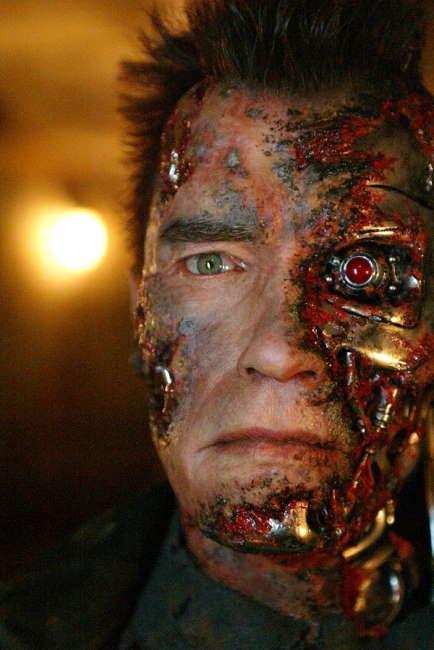
Overview: What happens if you take the original Terminator idea, morph it with T2, get rid of any semblance of a coherent, cool story, but add a really hot chick in leathers kicking butt to it? Answer: Terminator 3: Rise of the Machines! Director Jonathan Mostow really kicks the FX up a notch, but unfortunately, the story fades into more of a prop than the centerpiece it was in the first two movies. While the key cast members are all fine (terrific in the case of Lokken), they can only work with what they’re given.
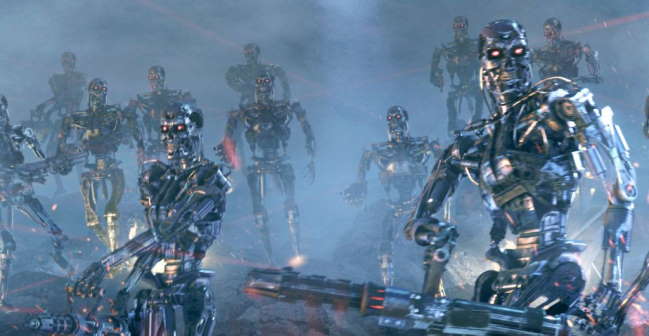
The Story: In Terminator 3, 10 years have passed since John and Sarah Conner destroyed Cyberdyne Systems and stopped the Skynet apocalypse. Unfortunately, it seems that the future is not what we make of it (As Desirina reminds us in the T2 comments), instead, fate is now predetermined. Why? Who knows…roll with it, buddy. You’ll get no well thought philosophical time travel notions here. Instead, the Terminator mystique is just that – a façade to get us to the juicy action sequences!
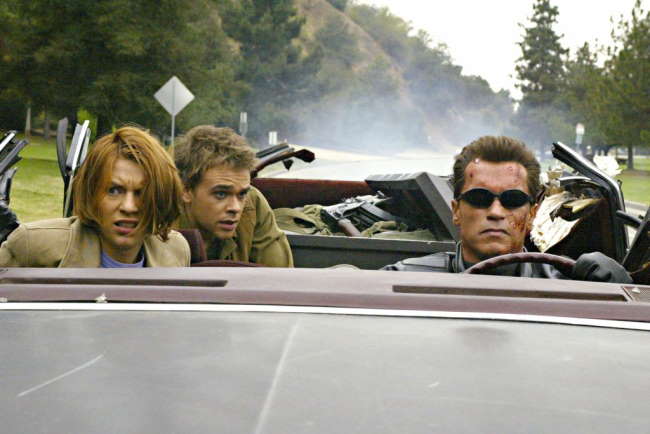
Over the years, John Conner (Nick Stahl) has turned into a drifter – he never really believed that the end of the world was abated, so he has spent his life leaving no clues as to his existence (no phones, bank accounts, and FORGET that damn phonebook!). He wrecks on his motorcycle, and due to his fear of hospital records, decides instead to break into a local veterinarian’s office and take some random medicine in the hopes that it’s a pain reliever (apparently, in the future time of 2003 the west has forgone local clinics that treat illegal aliens without recording their names and addresses). It just so has it that Conner has broken into a vet where Kate Brewster (Claire Danes), a former junior high fling of Conner’s, works.
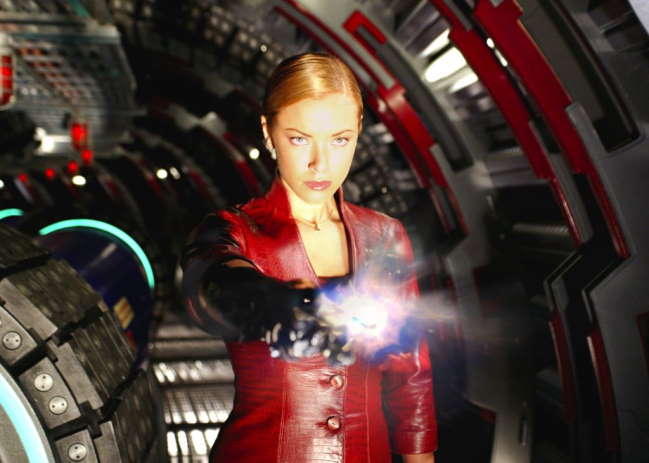
While this is going on, The TX (Kristanna Loken), or Terminatrix as Conner refers to her, arrives from the future. The new Terminatrix is nanotechnology enabled, and can control all computer networks and most electrically powered machines - in short, she’s a badass. Because Conner has all but disappeared, her mission is to bump off his lieutenants, and if possible, to then locate and terminate Conner. Arnold Schwarzenegger as the obselete CYberdyne Systems 101 model is once again captured in the future and dispatched in an attempt to save John Conner, and his future wife from the nuclear holocaust, and if possible, protect them from the Terminatrix.
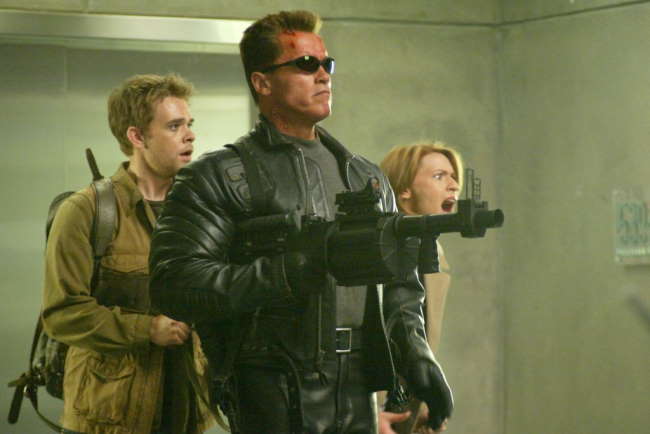
Philosophical Problems: I understand the desire to “go to the well” once more in the Terminator series, but it seems like they could have been a little more sophisticated in how they went about it. For instance, why, if Skynet is going to keep sending Terminators from the future, doesn’t it send them all back to 1984? Even a little throwaway line, similar to Star Trek’s magical matter-anti-matter converter, telling us that this isn’t possible would have helped this. Also, there’s the problem that Skynet’s grid was smashed in T1 – which was the whole purpose for the last ditched desparate attempt at a retroactive abortion. If the grid has been smashed (which if Skynet is an AI, what does this even mean?), how is it that Skynet can keep on producing newer Terminator models? Clearly, things are going all that badly for Skynet. I almost envision Skynet being in it’s “last throes” as similar to another conflict in today’s time.
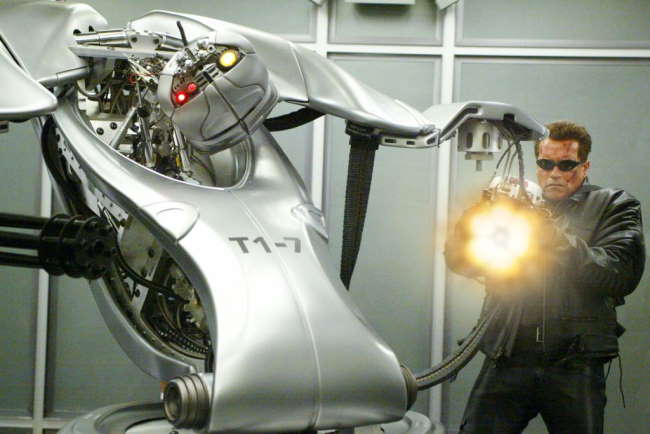
In T3, we get to see the first model Terminator.
More harmful than the problems above is the issue of fate being predetermined. Um, OK, sure, I suppose it could be, but couldn’t they have tried to justify this a bit more? The Original Terminator provided us a wonderfully nuanced time loop; Terminator 2 at least still kept a pretty solid story with the idea that the future is what we make of it. Terminator 3 basically says, “Fuck it. You’ll all screwed anyways, so lets just throw down!” And throw down they do.
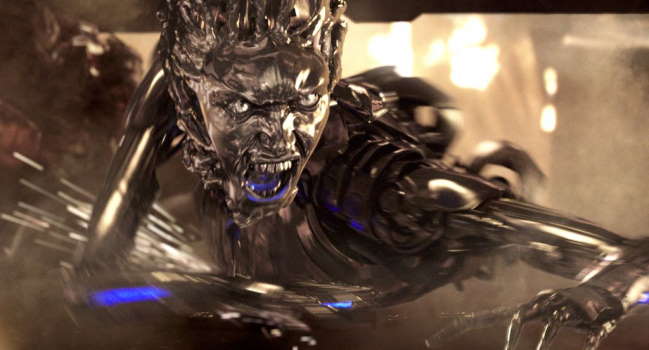
The FX: Although the story takes a significant hit in T3, the special effects do indeed rock in an over-the-top sort of fashion. I thought the truck-car race was a bit too over-done, but I LOVED the Terminatrix’s FX. And truly, Kristanna Lokken played her wonderfully. I loved her facial expressions and demeanor. She knew what the part was supposed to deliver (a hot android terminator chick kicking ass) and did it wonderfully. The FX surrounding her from beginning to end are reason enough to watch this movie.
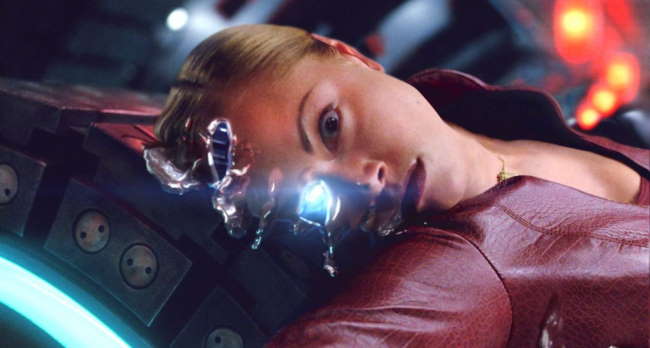
The Bottom Line: While this movie rates highly as a “hot chick kicking butt” flick, it suffers in comparison to its two predecessors as the ending to a trilogy. Terminator 3 certainly was enjoyable, but not in the sophisticated sense that the first or second one was. The sliding scale I see with this series is as follows: Terminator had an awesome story and pretty great visuals for its time; Terminator 2 delivered a very good story, and provided awesome visuals – the type that raise the bar on future movies; The third does away with the cool story but at least still delivers the visuals. In short, Terminator 3: Rise of the Machines is a bubble-gum chewing summer blockbuster, pure and simple. But on that level it works fine. However, based on the downward quality trend, if Abbot & Costello were still alive, I’d say that the next movie should be titled “Abbot and Costello Meet the Terminator.” Regardless, 5-6 stars is a reasonable place for a movie that delivers extremely well on the visuals but falls off on the story. In this case, 6 stars seems appropriate. Watch it for the FX and Kristanna Loken-Arnold battles, not for a continuation of the story.
~See movies similar to this one~
Year: 1998
Directed by: Takashi Miike
Written by: Itaru Era & Masa Nakamura (screenplay), Kozy Watanabe (novel)
IMDB Reference
Degree of Cyberpunk Visuals: Medium
Correlation to Cyberpunk Themes: High
Key Cast Members:
Mai Hitomi & Ai: Hiroko Shimabukuro
Yuu: Kenji Harada
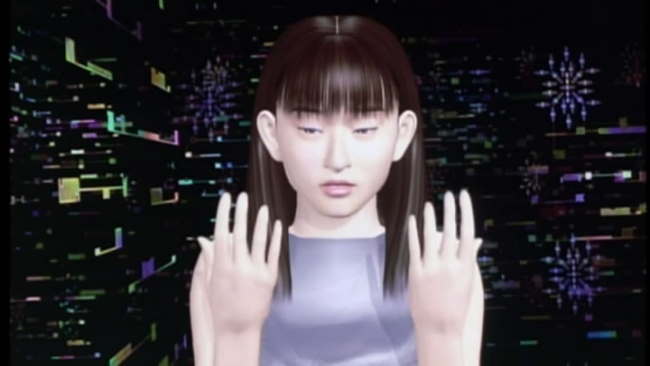
The forbidden Domain of God…I’ve stepped in to it.
Overview: Director Takashi Miike, better known for his hard edged gorefests like Ichii the Killer, delivers a far different fare with Andoromedia. Andoromedia stars actors from two Japanese pop groups: Speed and Da Pump. Overall, Andoromedia is a mixed bag: On the one hand we get an interesting story involving the recording of a human brain and recreation of a person in AI, yet on the other hand, the truly interesting implications of this are barely explored. Instead we get an evil corporation chasing the “good guys,” with a random music video thrown in for good measure.
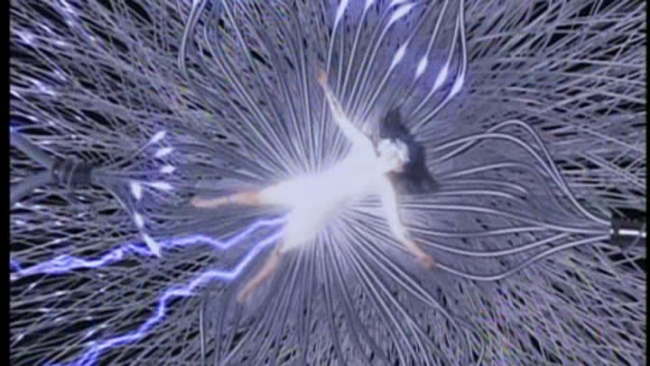
The Story: At some point in the very near future, an AI scientist, who has lost his wife prematurely, decides to invent technology to record his daughter’s memories. He does this continually over time, similar to how network administrators save backup tapes of their servers. He appears to have had a previous relationship with a shady VR corporation with roots both in Japan and the US, but has now severed ties with them. His Daughter, Mai (Hiroko Shimabukuro), falls in love with her longtime best friend, Yuu (Kenji Harada), and due to a freak “accident,” gets killed in a car crash.

The scientist, devastated, loads Mia’s memory backup into a VR facsimile of Mai – The facsimile’s name is “Ai,” and appears to be sentient. Ai remembers everything that happens to Mia, and is told that Mia has left this world, and that Ai and her “father” will live together from now on. Shortly thereafter, representatives from the corporation come and try to steal Ai and kidnap the scientist, but instead, the scientist frees his daughter into the net before being killed. Ai, now alone but having seemingly limitless capabilities on the net, eventually traverses the net and finds her boyfriend, Yuu, and her friends from school. Yuu falls even more deeply with Ai, but is soon pursued by the corporate goons who want to take Ai for their own nefarious purposes.
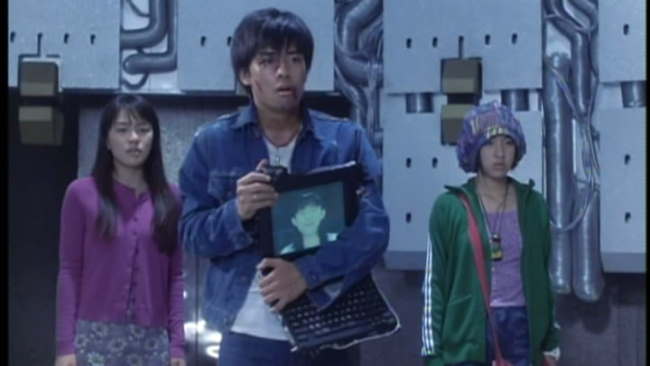
Philosophical Musings: Much of Andoromedia is “magical,” meaning they give no explanation how any of this occurs. Still, the ideas presented concerning the recording and transferal of human memories into a AI lifeform are rather intriguing. Unfortunately, Andoromedia examines these ideas for only 20 minutes or so. Ai “knows” she is not Mia, and understands that these memories belong to someone else. Yet over time, she begins to “feel” for love towards these people from another’s memories. Over time she grows to become “Mia.” This includes an Ai version of the “coming of age” story. This story of course also raises questions concerning her viability as an equal lifeform, but these questions really never get explored.
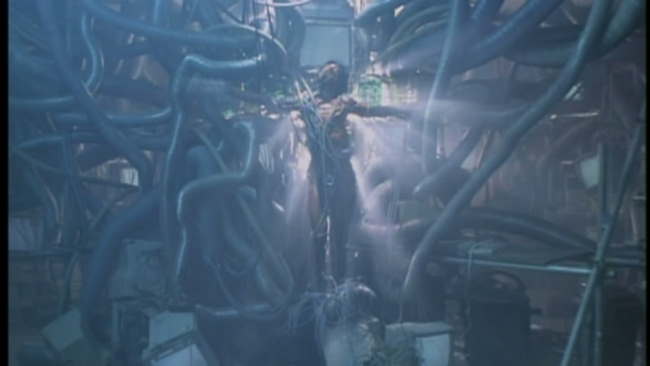
The Visuals and Pacing: Andoromedia stars off as a Japanese teenie-bopper movie, but as things progress, we get interesting VR visuals, and darker surroundings. The set designs and computer graphics are low-end but futuristic looking. The pacing is inquisitive at the beginning, but then devolves into a standard chase type pacing. Only at the end does it return to its introspective beginnings.
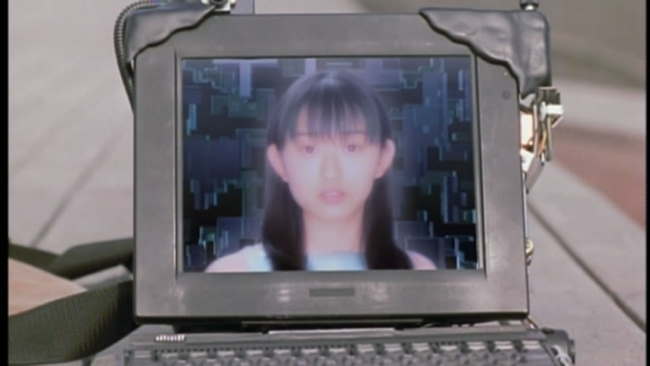
The Bottom Line: Andoromedia provides enough ideas to be interesting. I would have wished Miike took this plot in a more insightful direction, but he apparently wanted to keep some of the kookiness running throughout (the American evil corporate leader, played by Hero Cinematographer, Christopher Doyle, is especially kooky). The two leads do a decent job and have nice chemistry. Overall, aside from the random “Da Pump” band video thrown in the middle, Andoromedia is decent, but not great fare.
~See movies similar to this one~
Year: 1995
Directed by: Brett Leonard
Written by: Eric Bernt
IMDB Reference
Degree of Cyberpunk Visuals: Medium
Correlation to Cyberpunk Themes: Low
Key Cast Members:
Lt. Parker Barnes: Denzel Washington
SID 6.7: Russell Crowe
Dr. Madison Carter: Kelly Lynch
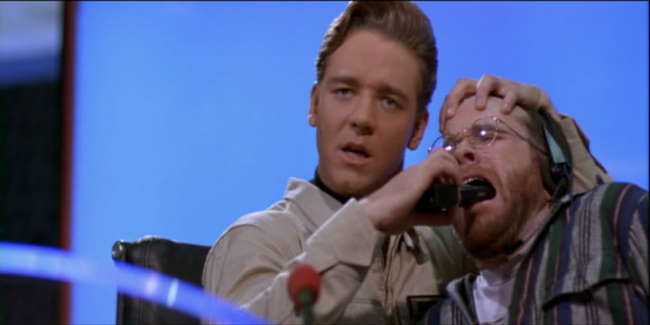
Overview: Overview: Sometimes we find movies are able to rise above truly absurd stories and transform movies that had no business being watchable into something enjoyable. This is what we find with Virtuosity. Virtuosity has a story with is barely bothers to try to hold together, but yields memorable performances by all the major leads. The pacing is at least fast enough that its possible that some unsuspecting viewers might not notice some of the absurdities presented.
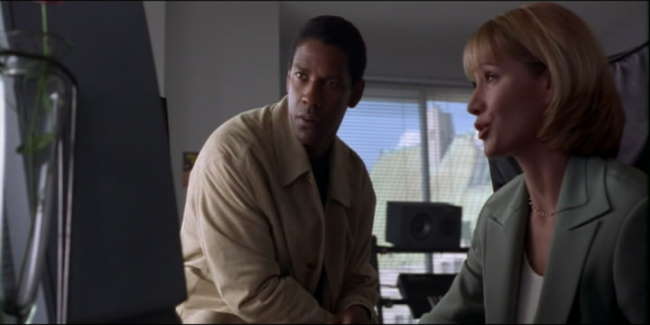
The Story: In the near future, Crowe plays SID 6.7, a virtual reality (VR) composite of 200 personalities, each and every one a killer. His purpose is to serve as the key bad guy in a new police officer training simulation. To test the simulation the corporation uses former cops – now criminals – to test the hyper-real VR training system. Former Lt. Parker Barnes, convicted for killing a mass murderer (and some bystanders) who murdered his family is one of the lucky ginea pigs. After entering the simulation, all is not as is seems, as SID 6.7, who has grown sentient, has modified the safety controls to allow him to actually kill the test subjects. Barnes’ partner is killed and Barnes barely escapes the Simulation.
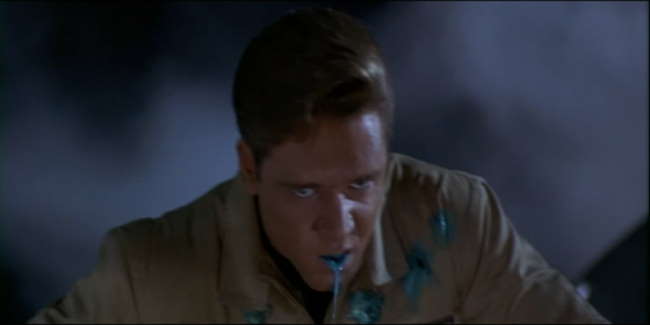
After the corporation decides to shut the project down, Dr. Lindenmeyer (played by Stephen Spinella), SID 6.7’s creator finds a way to save SID 6.7. It just so happens that another scientist in the corporation has just completed a nano-android – the first of its kind – and is now wondering how to embed it with sentience (yes, they really expect us to buy this – companies always have magical projects just hanging around that anyone can get access to!). Lindenmeyer tricks the scientist into uploading Crowe’s program into the nano-droid, which serves to free SID 6.7 from his simulated cage.
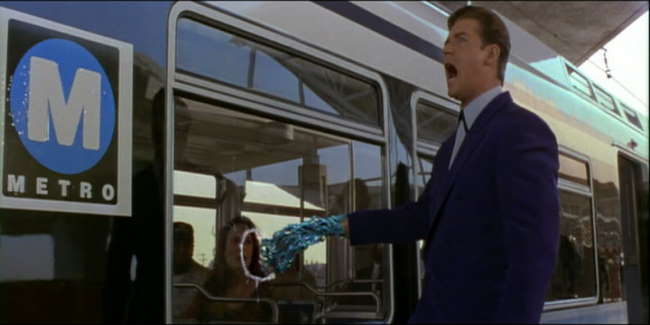
It turns out that one of SID 6.7’s “dominant” personalities which he has been created by is none other than the murderer of Parker’s family. Parker is offered a pardon if he can capture or kill SID 6.7. Parker is joined by Dr. Madison Carter (Kelly Lynch), an expert on serial killers. From this point on, we get a police-serial killer chase movie with a good bit of cool nano-droid restoration visuals. The rationale for why the police can’t stop SID 6.7, or why Dr. Carter must join parker are both pretty weak. More interesting is the fact that the police never seem to bother showing up when SID 6.7 decides to kill people in front of massive crowds. But such is life – again, at least the leads all play this far more believable than this film has a write to be.
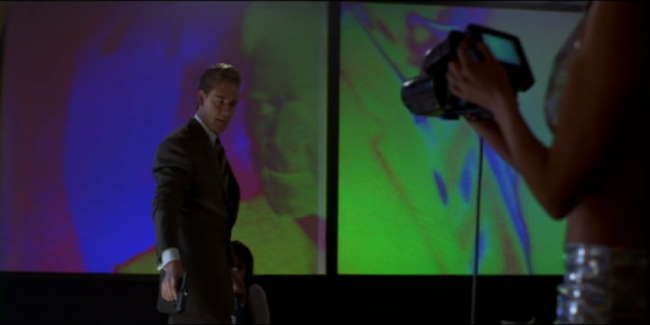
The Bottom Line: The VR visuals are decent, the acting is very good, but the story really doesn’t hold together. The worse part of the story is that the the nano-droid and VR sentience are essentially posed as magic. We get no explanation from the key cyberpunk aspects of this, such as how 200 real-life personalities from dead serial killers are embedded in a VR simulation, nor are we are given an explanation for how this incredible nano-droid is developed, or could be developed while not having a purpose. Still, Russell Crowe as a very memorable crazed villain and Denzel Washington both put in great performances, and are very well supported by Kelly Lynch, William Forsythe (a crusty police chief and Parker’s former boss) and William Fichtner (who plays a creepy corporate type). In short, they make the movie worth watching.
~See movies similar to this one~
Year: 1995
Directed by: Rachel Talalay
Written by: Alan Martin & Jamie Hewlett (comic strip), Tedi Sarafian (script)
IMDB Reference
Degree of Cyberpunk Visuals: Low
Correlation to Cyberpunk Themes: Low
Key Cast Members:
Tank Girl: Lori Petty
Jet Girl: Naomi Watts
Kesslee: Malcolm McDowell
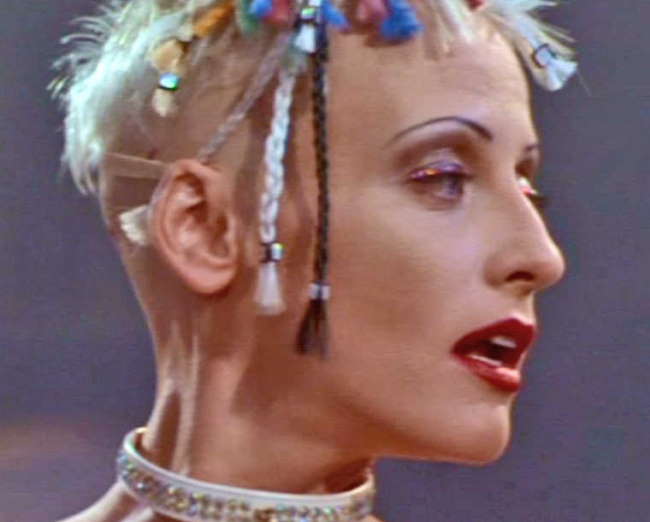
“Look, if you want to torture me, spank me, lick me, do it. But if this poetry shit continues just shoot me now please. .”
Overview: If you’re looking for an off-beat, low-budget cyberpunk comedy, Tank Girl is your movie. Talk about a weird flick! Lori Petty finds her calling here as an anti-heroine called Tank Girl, a light spirited soul living in a dystopic near-future caused by a comet hitting the earth. The evil water and power company, lead by Kesslee (Malcolm McDowell) has gathered up all the remaining water sources on earth (it hasn’t rained in 11 years) and is hoarding water (now the most valuable commodity on earth) in order to maintain power over the rest of the surviving stragglers. Tank Girl, while riding around in a tank, leads the resistance made up of some of the most bizarre misfits against the evil water and power company. With Jet Girl (Naomi Watts) in tow, there is nothing they can’t do, but first they want to have some non-sequitur fun!
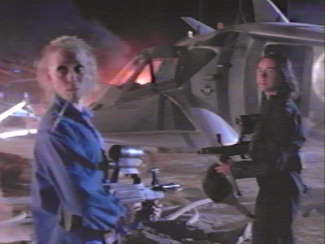 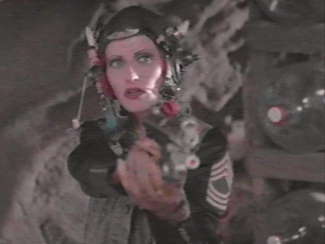
“This comet came crashing into the earth. BAM! Total devastation. No celebrities, no cable TV, *no water*! It hasn’t rained in 11 years. Now, 20 people gotta squeeze into the same bathtub. So it ain’t all bad.”
The Bottom Line: Truly, this movie is just strange. We get everything from bizarre, over-the-top scenes, to dances, to massive killing, all wrapped in truly odd dialogue. Tank Girl and Jet Girl make a terrific combination, but this movie is just not meant to be taken seriously. NOBODY takes the plot seriously - the entire cast knows how wierd this looks and continually seem to provide meta-comments to that effect. While this movie does drag in places, the cast is truly seems to be enjoying themselves, and in the process, they make Tank Girl enjoyable. I must confess - I’ve never seen the comic strip that Tank Girl is based off, but I can’t imagine it’s as zany as the the movie is. Again, this isn’t a great movie by any stretch, but it is pretty fun.
~See movies similar to this one~
|






































































